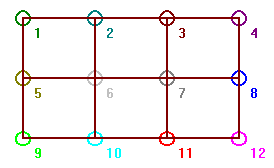Graph Theory Lessons



 Lesson
19: Grids
Lesson
19: Grids

The program allows you to easily draw rectangular
and triangular grids. Click Graph and Grids and then Rectangles
When asked for the number of vertices across enter 4 and when asked the
number of vertices down enter 3. You will get a graph like fig. 31. If
m>1 and n>1 we shall call an m by n rectangular
grid Sqm,n.

|
|
Fig. 31, The grid Sq4,3.
|
-
Look at the statistics of a few rectangular grids
and find a formula for the number of edges in Sqm,n.
[Hint: How many horizontal edges and how many vertical edges are there?]
-
If m>1 and n>1,
-
how many vertices of degree 2 does Sqm,n
have?
-
How many vertices of degree 3 does Sqm,n
have?
-
How many vertices of degree 4 does Sqm,n
have?
-
What is the sum of the degrees of the vertices of
Sqm,n? Does that agree with your answer to question 1?
-
What is the chromatic
number of Sqm,n?
-
If Sqm,n is regular
then what are the possible values of m and n?
-
Find a Hamilton
circuit in Sq4,3 and one in Sq4,4.
-
If m and n are both odd then Sqm,n
has no Hamilton circuit. You might try to check Sq3,3
but be warned that it takes a very long time for the program to exhaust
all the possibilities and give up trying. To prove that there is no hamilton
circuit answer the following questions:
-
How many vertices are there in Sqm,n?
-
How many edges will there be in a Hamilton circuit
on Sqm,n?
-
Suppose that in a Hamilton circuit you have r
right moves, l left moves, u upward moves and d downward
moves. How are r and l related and how are u and d
related?
-
If h is the total number of edges in the hamilton
circuit then h=r+l+u+d. Why is this impossible?
-
Clearly Sq2,2 has an Euler
circuit. Is there any other square grid with an Euler circuit? (Sq1,1
doesn't count!) [ Hint: Use your answer to question 2 .]
In the same way as the square grid, you can obtain a triangular grid
by choosing Graph then Grids then Triangles. Study
the statistics for a few triangular grids.
-
Does a triangular grid always have an Euler circuit?
(Why or why not?)
 e-mail: C.
Mawata
e-mail: C.
Mawata



 © C. Mawata
© C. Mawata


 Lesson
19: Grids
Lesson
19: Grids

